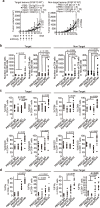HVJ-E links Apolipoprotein d to antitumor effects
- PMID: 40541272
- PMCID: PMC12182123
- DOI: 10.1136/jitc-2024-011442
HVJ-E links Apolipoprotein d to antitumor effects
Abstract
Background: Virotherapy eradicates tumors by directly killing cancer cells and causing adjuvant effects. However, the mechanism by which non-replicating virotherapy exerts anti-tumor effects is unclear.
Methods: In this study, we investigated the genes that mediate the anti-tumor effects of ultraviolet (UV)-irradiated Hemagglutinating Virus of Japan envelope (HVJ-E) using RNA sequencing, gene knockout, and a drug-inducible gene expression system. We examined the antitumor effects of Apolipoprotein d (Apod) using genome-wide CRISPR library screening, in situ biotinylation combined with mass spectrometry, flow cytometry, biochemistry, and tumor-bearing mouse models.
Results: Here, we show that HVJ-E represses tumor growth via Irf7-induced Apod expression in tumor cells in vivo. Irf7 in B16F10 cells is a pivotal transcription factor for HVJ-E-induced anti-tumor effects. Apod substantially suppresses tumor growth even in HVJ-E-insensitive tumors. Apod is required to increase NKG2D-ligand genes in HVJ-E-treated tumors. Genome-wide CRISPR library screening and in situ biotinylation of Apod reveal an association of Apod with ERK2. Mechanistically, Apod prevents the nuclear translocation of ERK2 and Importin7, increasing NKG2D-ligands expression in B16F10 cells and attenuating tumor growth. Treating a local tumor with a combination therapy of Apod with the anti-OX40, T cell costimulatory molecule, antibody substantially repressed tumor growth in target and non-target lesions alongside T cell activation.
Conclusion: Our findings provide insights into the molecular mechanisms of how HVJ-E induces anti-tumor effects and can aid the development of therapeutic strategies for eliciting anti-tumor immunity.
Keywords: Abscopal; Oncolytic virus; co-stimulatory molecules.
© Author(s) (or their employer(s)) 2025. Re-use permitted under CC BY-NC. No commercial re-use. See rights and permissions. Published by BMJ Group.
Conflict of interest statement
Competing interests: KN and AI applied for a patent based on the study with Osaka University.
Figures






References
MeSH terms
Substances
LinkOut - more resources
Full Text Sources
Research Materials
Miscellaneous
